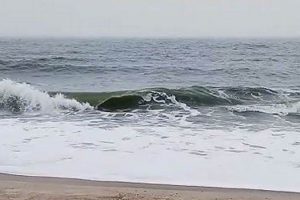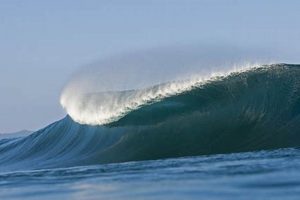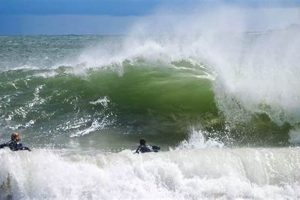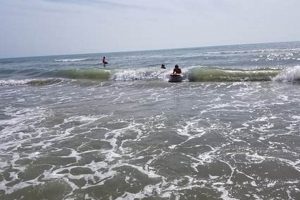Information regarding wave conditions at a specific coastal location is crucial for surfers. This data typically encompasses wave height, swell direction, water temperature, and wind conditions. Access to this information allows individuals to make informed decisions about safety and optimize their surfing experience. For example, a forecast might indicate small waves and offshore winds, suggesting favorable conditions for beginners.
The availability of precise coastal data contributes significantly to risk management and enjoyment of the sport. Understanding potential hazards, such as strong currents or hazardous marine life, is facilitated through reliable information sources. Moreover, awareness of historical trends in wave patterns can aid in predicting future conditions, enhancing the planning and preparation of surf sessions. Furthermore, the ability to forecast or track conditions allows surfing event organizers to secure appropriate times for competition.
The following sections will delve into the nuances of interpreting coastal data, its sources, and how to utilize it effectively to improve surfing performance and ensure a safe and rewarding experience on the water.
The following guidelines assist in the proper interpretation and application of coastal wave data for safe and informed surfing decisions.
Tip 1: Consult Multiple Sources: Do not rely solely on a single data provider. Cross-reference information from various sources to gain a comprehensive understanding of the prevailing conditions.
Tip 2: Understand Wave Height Metrics: Be aware of the differences between swell height, wave face height, and significant wave height. Swell height represents the open-ocean wave size, while wave face height is the estimated size of the wave a surfer will encounter. Significant wave height is the average of the highest one-third of waves.
Tip 3: Analyze Swell Direction: Assess the angle at which swells are approaching the coastline. Changes in swell direction can significantly impact wave quality and break patterns.
Tip 4: Evaluate Wind Conditions: Offshore winds typically groom waves, creating clean and well-defined surf. Onshore winds, conversely, tend to produce choppy and disorganized conditions.
Tip 5: Monitor Tide Levels: Observe the tidal cycle and its influence on wave breaking. Certain surf breaks perform optimally at specific tidal stages.
Tip 6: Consider Water Temperature: Be mindful of water temperature and dress appropriately to prevent hypothermia or discomfort. Wetsuit thickness should be adjusted based on the expected water temperature.
Tip 7: Assess Local Hazards: Be aware of potential hazards such as rocks, reefs, strong currents, and marine life. Consult local resources or experienced surfers for information on specific dangers.
Applying these guidelines enables individuals to make informed decisions regarding surf conditions, enhancing safety and maximizing enjoyment. Accurate assessment of coastal wave information is paramount for all surfers.
The subsequent sections will delve into the practical aspects of utilizing wave data to improve surfing technique and overall performance.
1. Wave Height
Wave height represents a critical parameter within a coastal data analysis. It directly influences surfability, safety, and overall enjoyment. Measurements typically encompass swell height, wave face height, and significant wave height, each offering distinct information. Underestimating wave height can lead to hazardous conditions, while overestimating may result in missed opportunities. For example, a report indicating a significant wave height of 3 feet may translate to wave faces of 4-5 feet, suitable for intermediate surfers. This relationship is integral to assessing conditions at Salt Creek.
The correlation between swell direction and wave height is significant. A swell approaching from an optimal angle will maximize wave height at a particular break, whereas an unfavorable angle may diminish it. Furthermore, tidal influence modulates wave height; higher tides can dampen wave energy at certain locations, while lower tides may amplify it. Analyzing past wave data provides insights into these dynamic relationships. For instance, historical coastal wave data at Salt Creek illustrates a positive correlation between southwest swells and increased wave height during mid-tide.
Accurate interpretation of wave height data is essential for coastal safety and optimized performance. Factors such as skill level, equipment, and local conditions must be considered in conjunction with wave height forecasts. Consistent monitoring of coastal wave data and a thorough understanding of its influence are key to responsible surfing and risk mitigation. A comprehensive report, including precise wave height measurements, strengthens informed decision-making and promotes safer water activities.
2. Swell Direction
Swell direction constitutes a crucial component of a comprehensive coastal data analysis, directly influencing wave size, shape, and break location. At Salt Creek, specific swell angles are more conducive to optimal surf conditions than others due to the bathymetry and orientation of the coastline. For instance, a swell originating from the southwest (225 degrees) typically produces well-formed, rideable waves, particularly at the break known as “The Point.” In contrast, a swell from the northwest (315 degrees) may result in less organized wave patterns or a shift in the primary breaking zone to another part of the beach. Thus, understanding the direction of incoming swells is paramount for predicting the suitability of surfing conditions at different locations within Salt Creek.
The relationship between swell direction and wave quality is further modulated by factors such as swell period and wind conditions. A long-period swell (e.g., 12 seconds or greater) originating from the southwest can generate powerful, clean waves, provided that winds are light or offshore. However, the same swell, coupled with onshore winds, may produce choppy, less desirable conditions. Conversely, a shorter-period swell (e.g., 8 seconds) from a similar direction may generate smaller, more manageable waves, suitable for beginner surfers. Examining historical coastal data for Salt Creek, it is evident that a southwest swell combined with a light offshore wind consistently correlates with optimal wave conditions at most breaks along this stretch of coastline.
In summary, swell direction plays a pivotal role in determining surf conditions at Salt Creek. Its accurate assessment, combined with considerations of swell period, wind, and tide, enables surfers to anticipate wave quality and select appropriate locations. Misinterpreting swell direction can lead to wasted time or even hazardous situations. Continuous monitoring and analysis of coastal data, with a specific focus on swell angles, are essential for maximizing the surf experience and ensuring safety at Salt Creek.
3. Wind Speed
Wind speed is a significant determinant of wave quality as captured in coastal data. Its impact is primarily observed through the creation of chop or the grooming of wave faces. High wind speeds, particularly those blowing onshore, introduce surface texture, disrupting wave formation and reducing rideability. Conversely, light to moderate offshore winds can refine wave shape, holding up the wave face and creating a smoother surface, which is generally desirable for surfing. The coastal data often specifies both wind speed and direction to provide surfers with a complete picture of prevailing conditions. For example, a coastal report indicating 15 knots of onshore wind would likely correlate with choppy, less defined waves, whereas a report indicating 5 knots of offshore wind would suggest cleaner, more surfable conditions. This illustrates a cause-and-effect relationship directly affecting the value of the surfing session.
The influence of wind speed varies depending on the location and its exposure to prevailing wind patterns. Certain coastal areas are more sheltered from the wind than others, mitigating its negative effects. At Salt Creek, for instance, certain breaks may be partially protected from strong northwest winds, allowing for relatively cleaner waves even when other nearby locations are experiencing unfavorable conditions. Monitoring wind speed in conjunction with other coastal data parameters such as swell direction and tide level, further refines the understanding. A strong offshore wind can, in certain conditions, negate the effects of a less-than-ideal swell direction. This interplay demands constant observation and experiential understanding for accurate assessments.
In summary, wind speed constitutes a vital component in coastal condition assessment. Understanding its effects is crucial for accurately predicting wave quality and planning surf sessions. Inadequate consideration of wind speed can result in wasted effort and potentially dangerous conditions. Integrating wind speed data with other relevant factors offers a comprehensive and actionable understanding of coastal wave dynamics. By doing so, individuals may choose a time when the waves are best, or change location to take better advantage of wind patterns relative to wave action, thereby creating a safer, more beneficial environment.
4. Tide Levels
Tide levels are a critical factor influencing surf conditions at Salt Creek. Fluctuations in water depth alter wave breaking characteristics, influencing wave size, shape, and overall surfability. Understanding the relationship between tide levels and wave dynamics is essential for accurately interpreting any Salt Creek coastal wave information.
- Wave Breaking Zone
Tide levels directly affect the location and intensity of the wave breaking zone. At high tide, waves may break further offshore, potentially reducing wave size and intensity at certain reef or point breaks. Conversely, low tide can cause waves to break closer to shore, increasing their steepness and power, but also potentially exposing shallow reefs and hazards. Examining tide charts provides insights into these changes.
- Wave Shape and Quality
Tide levels significantly impact wave shape and quality. Rising tides often smooth out wave faces, creating more uniform and predictable conditions. Falling tides, on the other hand, can lead to more erratic and unpredictable wave patterns. At Salt Creek, certain breaks perform optimally during specific tidal stages, as water depth interacts with the underwater topography.
- Currents and Rip Tides
Tidal fluctuations influence the strength and direction of currents, including rip currents. Rip currents are particularly hazardous, as they can rapidly pull surfers away from the shoreline. During periods of significant tidal change, rip currents may become stronger and more prevalent. Awareness of tidal currents is critical for surfer safety, particularly for inexperienced individuals.
- Accessibility and Hazards
Tide levels affect accessibility to certain surf breaks and the visibility of underwater hazards. Low tide can expose shallow reefs and rocks that pose a danger to surfers. Additionally, certain breaks may only be accessible at specific tidal stages due to the presence of submerged or exposed obstacles. Consideration of tide levels is essential for safe access and risk mitigation.
The integration of tide level information with other components of the Salt Creek coastal data, such as wave height, swell direction, and wind conditions, enhances the accuracy of predicting surf conditions. Accurate interpretation of tidal influences is essential for maximizing surfing performance and minimizing potential hazards at this location.
5. Water Temperature
Water temperature is a critical component of coastal data, directly influencing surfer comfort, safety, and equipment selection. A “salt creek surf report” that omits water temperature is incomplete, as this variable determines appropriate exposure protection. Colder water temperatures necessitate thicker wetsuits or additional layers to prevent hypothermia, while warmer temperatures may allow for surfing in boardshorts or springsuits. Failure to consider water temperature can lead to discomfort, reduced performance, and potentially life-threatening conditions.
The annual water temperature cycle at Salt Creek exhibits significant variability. During winter months (December-February), water temperatures can drop to the low 50s Fahrenheit, requiring a full wetsuit with a hood and booties. Conversely, summer months (July-September) can see temperatures rise to the mid-60s, allowing for more comfortable surfing in a springsuit or even boardshorts. Sudden shifts in water temperature, often driven by upwelling events or changes in ocean currents, can occur rapidly, underscoring the importance of regularly consulting the “salt creek surf report” and adjusting attire accordingly. Furthermore, understanding water temperature trends can inform decisions about travel planning, allowing surfers to target periods with optimal conditions. For example, a surfer planning a trip to Salt Creek in October should anticipate potentially cooler water and pack appropriate thermal protection.
In summary, water temperature is an indispensable element of any comprehensive coastal data presentation. The “salt creek surf report” that incorporates accurate and timely water temperature data empowers surfers to make informed decisions regarding equipment, safety, and overall surf experience. Neglecting this factor can result in discomfort, reduced performance, and potentially hazardous situations. Continuous monitoring and consideration of water temperature are crucial for responsible and enjoyable surfing at Salt Creek.
6. Local Hazards
The presence of environmental hazards necessitates diligent consultation of available coastal information. Neglecting these considerations can result in serious injury or property damage. The following outlines critical hazard-related data relevant to interpreting surf conditions.
- Submerged Rocks and Reefs
The underwater topography at Salt Creek includes submerged rocks and reefs that pose a significant threat to surfers. These hazards are often difficult to discern, particularly during periods of high tide or turbulent conditions. A comprehensive assessment includes information regarding the location and depth of these submerged obstacles.
- Strong Currents and Rip Tides
Strong currents and rip tides are prevalent along the Salt Creek coastline, capable of rapidly carrying individuals away from shore. Information regarding tidal influences and typical current patterns is crucial for risk assessment. Reports should indicate the presence of known rip current locations and provide guidance on escape strategies.
- Marine Life Encounters
The waters off Salt Creek are home to various marine species, some of which may pose a threat to surfers. Encounters with sharks, jellyfish, or other marine life can result in injury or even death. The coastal data should include reports of recent sightings or any known seasonal risks associated with marine life.
- Pollution and Water Quality
Water quality conditions can fluctuate, potentially exposing surfers to harmful bacteria or pollutants. Periods of heavy rainfall often lead to increased runoff and contamination. The coastal data should include information regarding water quality testing results and any advisories issued by local authorities.
Thorough evaluation of all available information regarding local hazards is essential for mitigating risk. A comprehensive report that integrates hazard data with other coastal parameters provides surfers with the knowledge necessary to make informed decisions and ensure a safe and enjoyable experience. Diligence and awareness are paramount when navigating potentially hazardous conditions.
Frequently Asked Questions
The following section addresses common queries regarding the interpretation and application of wave information specific to Salt Creek, aiming to provide clarity and enhance user understanding.
Question 1: What is the typical frequency of updates for the Salt Creek surf report?
Update frequency varies depending on the data source. However, reputable providers typically offer updates at least every six hours, with some providing real-time or hourly data during periods of rapidly changing conditions. Frequent consultation is advised to ensure the information remains current.
Question 2: How accurate are the wave height predictions in the Salt Creek surf report?
Wave height predictions are based on mathematical models and are subject to inherent limitations. Accuracy can be affected by factors such as storm intensity, swell direction, and local bathymetry. It is recommended to consult multiple sources and interpret predictions as estimates rather than absolute values.
Question 3: Where can I find historical Salt Creek surf report data for research purposes?
Archived data is sometimes available from governmental agencies, academic institutions, or private weather service providers. The availability and format of historical data vary. Some sources may require a subscription or fee for access.
Question 4: How does the tidal cycle impact the reliability of the Salt Creek surf report?
Tidal fluctuations significantly influence wave breaking characteristics. Reports that do not explicitly account for tidal stage should be interpreted with caution. Consider the relationship between tide levels and wave height when assessing suitability for surfing.
Question 5: What do the terms “swell period” and “swell direction” mean in the Salt Creek surf report?
Swell period refers to the time interval between successive wave crests, measured in seconds. Swell direction indicates the compass bearing from which the swell is approaching. Both parameters are critical for determining wave quality and break location.
Question 6: Should I rely solely on the Salt Creek surf report for safety information?
No. While the report provides valuable information, it should not be considered a substitute for personal observation and sound judgment. Always assess conditions firsthand and consult with experienced local surfers regarding hazards and potential risks.
Understanding the nuances of wave information and its inherent limitations is essential for responsible surfing. Critical evaluation, coupled with practical experience, enhances safety and maximizes the surfing experience.
The subsequent section will address advanced strategies for utilizing coastal data to improve surfing performance.
Conclusion
The preceding discussion has elucidated the critical components of coastal data and their specific relevance to Salt Creek. Comprehensive understanding of wave height, swell direction, wind speed, tide levels, water temperature, and local hazards is paramount for informed decision-making. The effective interpretation and application of a “salt creek surf report” directly impacts surfer safety, performance, and overall experience.
The availability and utilization of accurate coastal information represent a continuous endeavor. Ongoing advancements in technology and data collection methods promise to further enhance the precision and reliability of future “salt creek surf report” iterations. Diligent monitoring of coastal conditions remains an indispensable practice for all water users, fostering a culture of responsible engagement with the marine environment.







